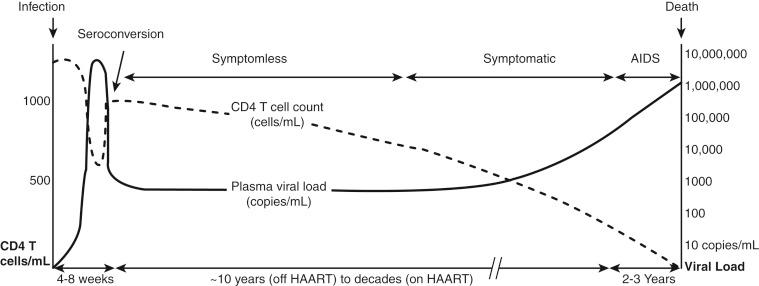Physical Address
304 North Cardinal St.
Dorchester Center, MA 02124
A 34-year-old woman with known human immunodeficiency virus (HIV) infection and a recent diagnosis of acquired immunodeficiency syndrome (AIDS) with Pneumocystis jirovecii (previously carinii ) pneumonia presents for elective cesarean section at 38 weeks’ gestation. She has not been followed by health care clinicians during her pregnancy and has not been taking antiretroviral therapy. She is very short of breath and has a dry cough, and her peripheral arterial oxygen saturation is 84% on room air. She weighs 62 kg, and her height is 164 cm. Her tympanic temperature is 37.2° C. She is alert and oriented, with no localizing neurologic signs. Her blood pressure is 90/50 mm Hg; her heart rate is 115 beats per minute, with no respiratory variation; and her respiratory rate is 26 breaths per minute. Recent laboratory tests show a CD4 T-cell count of 186 cells/mL and an HIV viral load of 240,000 copies/mL.
AIDS was first described in 1981 in the United States. HIV and, despite major therapeutic advances in recent years, the AIDS pandemic still pose a major threat to global health. It is estimated that more than 40 million people worldwide are infected with HIV, which is thought to have caused more than 20 million deaths to date. The infection continues to spread apace, with the most rapid increases observed in southern and central Africa and in South Asia. The predominant mode of HIV transmission is heterosexual sex, and women represent a high proportion of new infections, including in developed countries.
Increasing numbers of patients presenting for surgery are HIV-seropositive or have AIDS. Anesthesiologists should be familiar with this disease and be aware of the impact of HIV on anesthesia. An understanding of the pathogenesis of HIV and an awareness of the possible drug interactions occurring with HIV therapy may help guide the choice of anesthetic technique. The possibility of nosocomial transmission of HIV highlights the need for anesthesiologists to enforce rigorous infection control policies to protect themselves, other health care workers, and their patients. Antiretroviral therapy decreases the rate of disease progression, but there is no cure available, nor is a vaccine likely in the foreseeable future. With marked advances in treatment, the emphasis has shifted to early initiation of multidrug therapy regardless of immune status, and ongoing treatment to achieve HIV viral suppression throughout life.
HIV belongs to the family Retroviridae and the genus Lentivirus. Members of this genus are cytopathic (cell damaging), have long latent periods, and run a chronic course. When cases of AIDS first appeared, its pathogenesis was frustratingly elusive because the disease does not appear immediately on infection with HIV. There is a variable period during which the patient remains healthy but is viremic.
Acute seroconversion illness occurs with a high viral load soon after infection. After several months, there is a gradual decrease in the viremia as the immune response occurs. The viral load is often at a steady state as the rate of viral production equals the rate of destruction. Up to 98% of T-helper lymphocytes (CD4 T cells) are located in lymph nodes, which are the major site of viral replication and T-cell destruction. There is a gradual involution of the lymph nodes, with a concomitant decrease in CD4 T cells and an increase in viral load as the inexorable onset of AIDS occurs ( Fig. 9.1 ).

Before 1995, prospects for the treatment of HIV were gloomy. Subsequently, the situation changed dramatically as a result of four factors:
Improved understanding of the pathogenesis of HIV infection
Availability of surrogate markers of immune function and plasma viral burden
Development of new and more powerful drugs, such as the protease inhibitors and nonnucleoside reverse transcriptase inhibitors
Completion of several large clinical end-point trials that conclusively demonstrated that antiretroviral combinations significantly delayed the progression of HIV disease to AIDS and improved survival
In more recent years, advances have further transformed the treatment of HIV with more drugs, fewer side effects, less toxicity, and less pill burden. It has also been established that early initiation of therapy, regardless of the host’s CD4 T-cell count, renders the virus virtually undetectable, restores immune function, improves quality of life, prevents transmission, reduces HIV-associated morbidity, and lengthens survival. HIV has thus been rendered a less debilitating and ominous infection. Indeed there are real prospects for arresting the pandemic and potentially even eradicating HIV as a major infectious disease threat.
HIV is a virus found mainly in CD4 T cells, macrophages, and monocytes, and it requires a large infecting dose for transmission. HIV has been isolated from blood, cerebrospinal fluid, tears, saliva, semen, synovial fluid, pleural fluid, peritoneal fluid, pericardial fluid, amniotic fluid, vaginal secretions, and breast milk. Modes of transmission are through oral, rectal, and vaginal sexual intercourse, blood product transfusion, shared intravenous needles, occupational acquisition, and vertical transmission from mother to child. The screening of blood products for HIV antibodies has reduced the risk of transfusion-associated infection (less than 1 per 750,000 donor units); the exact risk is difficult to quantify, however. Antibody screening fails to detect the virus in the so-called window period before antibody formation, which lasts about 3 months. Nuclear amplification is an alternative technique that has been adopted and allows for early virus detection.
Become a Clinical Tree membership for Full access and enjoy Unlimited articles
If you are a member. Log in here